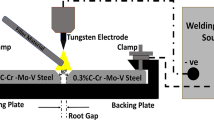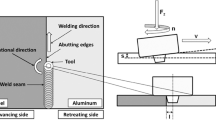Abstract
Robotic cold metal transfer (CMT) welding was recently suggested as a feasible process for joining of aluminum to steel for automotive applications. To promote an understanding of the process and the effect of process parameters on joint properties for selected sheets, CMT welding experiments have been performed. Commonly used materials in automotive industry, 0.75-mm DX54D+Z galvanized steel and 1.0-mm EN-AW-5754-H111 alloy, have been used in this study. Total number of 16 welds has been obtained using various parameters such as a wire feeding speed, welding speed, and torch deviation distance by means of L16 array Taguchi analysis. The aim of the study is to analyze the microstructure-strength relationship taking into account heat input-intermetallic compound (IMC) layer developed between aluminum and steel after determining the optimum process parameters based on the peak load for mechanically sound weld. Optimum parameters for 1.0-mm thick EN-AW 5754-H111 aluminum alloy to 0.75-mm thick DX54D+Z galvanized steel using the CMT process have been determined for the wire feeding speed range of 4–5 m/min, a welding speed range of 8–10 mm/s, and deviation distance range of 0–1 mm. The IMC layer thickness formed between aluminum and steel varied between 2 to 13 μm for different heat input values. Energy dispersive spectroscopy (EDS) analysis have been done at two different zones, galvanized steel side (IMC layer) and aluminum alloy side. The intermetallic compound layer consisted of two different phases: Fe2Al5 phase formed near the galvanized steel side and FeAl3 phase penetrated towards the Al alloy side.












Similar content being viewed by others
References
Miller WS, Zhuand L, Bottema J, Wittebrood AJ, De Smed P, Haszler A, Vieregge A (2000) Recent development in aluminum alloys for the automotive industry. Mater Sci Eng A280:37–49
G. Elaheh (2011) Materials in Automotive application, state of the art and prospects, New trends and developments in automotive industry. InTech
M. Potesser, T. Schoeberl, H. Antrekowitsch, J. Bruckner (2006) The characterization of the Intermetallic Fe-Al layer of steel-aluminum weldings. The Minetals, Metals & Materials Society
Thomy C, Wirth A, Kreimeyer M, Wager F, Vollertsen F (2007) Joining of dissimilar materials—new perspectives for lightweight design in the transportation industries. IIW conference, Dubrovnik, pp. 311–326
T.Sakiyama, Y.Naito, G.Murayama, K.Saita, Y.Miyazaki, H.Oikawa, T.Nose (2013) Dissimilar metal joining technologies for steel sheet and aluminum alloy sheet in auto body, Nippon steel technical report no:103
E.Taban, J.E. Gould, J.C.Lippold (2010) Dissimilar friction welding of 6061 -T6 aluminum and AISI 1018 steel: properties and microstructural characterization. Mater Des 2305–2311
Cao R, Yu G, Chen JH, Wang P (2013) Cold metal transfer joining aluminum alloys to galvanized mild steel. J Mater Process Technol 213:1753–1763
Franc A (2015) Heteregenous joints between steel and aluminum made by modified MIG process. meTal 2010:18–20.5
Dong H, Hu W, Wang Y, Dong C (2012) Dissimilar metal joining of aluminum alloy to galvanized steel with Al-Si, Al-Cu, Al-Si-Cu and Zn-Al filler wires. J Mater Process Technol 212:458–464
Lin J, Ma N, Lei Y, Murakawa H (2013) Shear strenght of CMT brazed lap joints between aluminum and zinc-coated steel. J Mater Process Technol 213:1303–1310
Shao L, Shi Y, Huang JK, Wua SJ (2015) Effect of joining parameters on microstructure of dissimilar metal joints between aluminum and galvanized steel. Mater Des 66:453–458
Dong HG, Liao CQ, Chen GQ, Dong C (2012) Butt jointing of aluminum to steel by arc brazing process. Mater Manuf Process 27:1392–1396
Chen Y, Weyland M, Hutchinson CR (2013) The effect of interrupted aging on the yield strength and uniform elongation of precipitation-hardened Al alloys. Acta Mater 61:5877–5894
Zhang HT, Feng JC, He P, Hackl H (2007) Interfacial microstructure and mechanical properties of aluminum–zinc-coated steel joints made by a modified metal inert gas welding–brazing process. Mater Charact 58:588–592
Liedl G, Bielak R, Ivanova J, Enzinger N, Figner G, Bruckner J, Pasic H, Pudar M, Hampel S (2011) Joining of aluminum and steel in car body manufacturing. Phys Procedia 12:150–156
Sierra G, Peyre P, Beaume FD, Stuart D, Fras G (2008) Steel to aluminum braze welding by laser process with Al–12Si filler wire. Science and Technology of Welding & Joining 13:430–437
Zhang HT, Feng JC, He P, Hackl H (2006) Interfacial microstrucutre and mechanical properties of aluminum -zinc coated steel joints made by a modified metal inter gas welding-brazing process. Mater Charact 58:588–592
S. Muncut, D. Mortoiu, G. Sima (2011) Technology for heterogeneous joining of thin zinc -plated steel sheet with aluminum. Noncenventional Technologies review no.4
Yang S, Zhang J, Lian J, Lei Y (2013) Welding of aluminum alloy to zinc coated steel by cold metal transfer. Mater Des 49:602–612
Taban E, Gould JE, Lippold JC (2010) Characterization of 6061-T6 aluminum alloy to AISI 1018 steel interfaces during joining and thermo-mechanical conditioning. Mater Sci Eng A 527:1704–1708
Mathers G (2002) in the USA The welding of aluminum and its alloys, first edn. Woodhead Publishing, Cambridge
Güngör B, Kaluç E, Taban E, Sık A (2015) Mechanical and microstructural properties of robotic cold metal transfer welded 5083-H111 and 6082-T651 aluminum alloys. Mater Des 54:207–211
Acknowledgments
This work was financially supported by The Scientific and Technological Research Council of Turkey (Tubitak) with the research Project under the scope no: 114M784. Authors would like to acknowledge Fronius Turkey and ICM Tissue Converting Machinery for technical support.
Author information
Authors and Affiliations
Corresponding author
Additional information
C-II Arc welding and Filler Metals
Rights and permissions
About this article
Cite this article
Ünel, E., Taban, E. Properties and optimization of dissimilar aluminum steel CMT welds. Weld World 61, 1–9 (2017). https://doi.org/10.1007/s40194-016-0386-9
Received:
Accepted:
Published:
Issue Date:
DOI: https://doi.org/10.1007/s40194-016-0386-9




